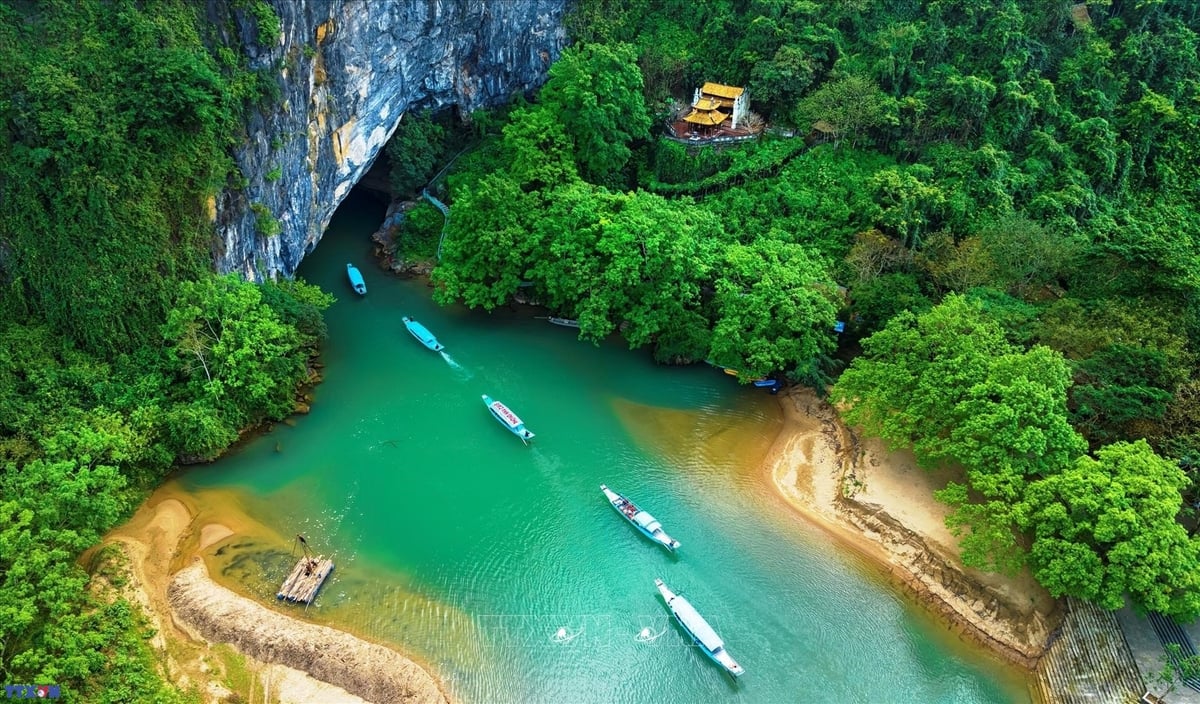December 1, 2025 | 11:40 GMT +7
December 1, 2025 | 11:40 GMT +7
Hotline: 0913.378.918
December 1, 2025 | 11:40 GMT +7
Hotline: 0913.378.918
In an official decision, the World Heritage Committee of UNESCO has expanded the boundary of the Phong Nha - Ke Bang National Park (Quang Tri Province, Vietnam) to include Hin Nam No National Park (Khammouane Province, Lao People's Democratic Republic). This park is a World Natural Heritage Site. The joint cluster is now known as "Phong Nha - Ke Bang National Park and Hin Nam No National Park".
This is the first transboundary World Heritage Site that Vietnam and Laos have jointly shared.

Vietnam has its first transboundary World Heritage Sites, namely Phong Nha-Ke Bang National Park and Hin Nam No National Park. Photo: VNA.
In 2009, the Prime Minister of Vietnam designated Phong Nha - Ke Bang National Park as a Special National Scenic Site. It was initially designated as a UNESCO World Natural Heritage Site on July 3, 2003, and was subsequently recognized for the second time on July 3, 2015. The park shares a natural boundary with Hin Nam No National Park and has a core area of 123,326 hectares and a buffer zone of 220,055 hectares.
In February 2024, the governments of Vietnam and Laos submitted a joint nomination dossier to UNESCO for the official designation of Hin Nam No as an extension of the existing World Heritage Site.
The World Heritage Committee approved the boundary extension under geological, geomorphological, ecosystem, and biodiversity criteria after UNESCO's advisory body submitted the decision based on the evaluation.
Some of the most pristine and exceptional limestone karst landscapes and ecosystems in the world are located in these two national parks. They lie at the junction of the Annamite Mountains and the Central Indochina Limestone Belt, spanning the border of Vietnam and Laos. Collectively, they contain over 220 kilometers of subterranean rivers and cave systems that are of global importance. The verdant tropical broadleaf forests of the region are home to a variety of endemic species, which are also famous for their exceptional biodiversity.
Phong Nha - Ke Bang alone is home to over 2,700 vascular plant species and 800 vertebrate species, including over 200 globally imperiled species as of its 2015 recognition, as well as 400 species that are endemic to Central Vietnam and/or Laos. Hin Nam No has documented more than 1,500 vascular plant species (from 755 genera) and 536 vertebrate species, a significant number of which are either globally imperiled or endemic. The site is home to 10 - 11 primate species, including the greatest remaining population of the southern white-cheeked gibbon, the endemic black langur, and four species that are endemic to the Annamite Mountains.
For years, the authorities of Vietnam and Laos have collaborated in the joint administration of Phong Nha—Ke Bang and Hin Nam No. This collaboration has included developing joint action plans to safeguard the shared heritage values and law enforcement activities.
Vietnam and the Lao People's Democratic Republic's preference and solidarity are further reinforced by the inclusion of this transboundary site in UNESCO's World Heritage List, which serves as a symbol of cultural and environmental collaboration between the two nations.
Vietnam now boasts nine World Heritage Sites
Nine UNESCO World Heritage Sites have been designated for Vietnam to date. These consist of two interprovincial sites: the Complex of Yen Tu - Vinh Nghiem - Con Son, Kiep Bac Relics and Scenic Landscape (Quang Ninh, Bac Ninh, and Hai Phong) and the Ha Long Bay - Cat Ba Archipelago (Quang Ninh Province and Hai Phong City ). This newly recognized listing is Vietnam’s first transboundary World Heritage Site.
Translated by Linh Linh

(VAN) The inevitable path forward is to reorganize production along the value chain, utilizing cooperatives as the core, enterprises as the driving force, and farmers as the central subjects.

(VAN) On November 28, Minister Tran Duc Thang, together with China's Minister of Agriculture and Rural Affairs Han Jun, chaired the 2nd meeting of the Viet Nam - China Agricultural Cooperation Committee.

(VAN) Forest carbon credits are only accepted when they ensure absolute environmental integrity, additionality, permanence, and transparency.

(VAN) Viet Nam partners with Beijing on controlling air pollution, cross-regional management, high-tech monitoring and relocating polluting facilities.

(VAN) With a USD 50 million investment, Australia is partnering with Viet Nam to operate its first public electric bus fleet and develop a nationwide EV charging network.

(VAN) On November 28, in Beijing, Minister Tran Duc Thang met Minister of Ecology and Environment of China Huang Runqiu, to share experience on environmental protection.
/2025/11/28/0950-2-120557_751.jpg)
(VAN) The recent flood spell in the South Central region clearly reflects the characteristics of natural disasters in 2025, which are compound, prolonged, and amplified.